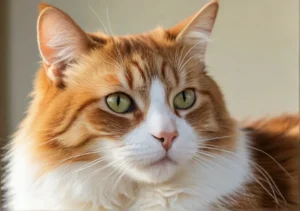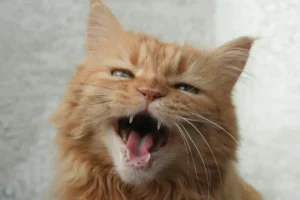Cats have a unique way of communicating with us through their meows, but have you ever wondered why they can only meow? Read on to uncover the fascinating reason behind this feline communication quirk.
The Anatomy of Meowing
Have you ever wondered why cats can only communicate through meows? Well, it all comes down to their unique anatomy. Unlike humans who have a wide range of vocalizations, cats are limited by their physiology.
One of the main reasons cats can only meow is because they lack the vocal cords necessary to produce intricate sounds. Cats have a specialized larynx that restricts their ability to create a variety of noises – hence the meow being their primary form of communication.
Another factor is the size of a cat’s larynx. It is relatively small compared to other animals, which further limits their vocal range. This restricted anatomy is why cats are generally unable to produce sounds like barks or roars.
In addition to their physical limitations, cats also rely on meowing as a way to get human attention. They have learned that this particular sound tends to garner a response from us, which is why they use it so effectively to communicate their needs and wants.
Evolutionary Adaptations
The evolution of cats’ meowing behavior is a fascinating tale of adaptation and survival. Domestic cats have learned to meow as a means of communicating with their human companions. This behavior has likely developed over thousands of years of cohabitation with humans.
In the wild, cats use a variety of sounds to communicate with each other, such as purring, growling, and hissing. However, meowing is a behavior that has been primarily reserved for interactions with humans.
Cats have learned that meowing can be an effective way to convey their needs, whether it be for food, attention, or simply companionship. Through evolutionary adaptations, cats have honed their meowing skills to better communicate and bond with their human counterparts.
So, the next time your feline friend lets out a meow, remember that it’s not just a simple sound – it’s a complex form of communication that has been evolved and perfected over time.
Vocalization Variations
Cats may only meow, but the range of sounds they produce is quite diverse. From short, high-pitched meows to long, low-pitched cries, each meow can convey different messages. For example, a short, sharp meow might indicate a request for attention or food, while a prolonged, drawn-out meow could signal distress or discomfort. Paying attention to these variations can help you better understand your feline friend’s needs and emotions.
Limitations of Meowing
While cats may be limited to meowing as their primary form of vocalization, it serves them well in their interactions with humans. Meowing is a learned behavior that kittens use to communicate with their mother, and they carry this over into adulthood when interacting with people. Unlike dogs, who have a wider range of vocalizations, cats rely on meowing to get their point across. Their meows can vary in tone, pitch, and intensity to convey different meanings, making them effective communicators despite this limitation.
Reasons Cats Meow:
- Attention: Cats meow to get your attention and communicate their needs.
- Hunger: A hungry cat might meow to let you know it’s mealtime.
- Stress or Anxiety: Cats can meow more when they are feeling anxious or stressed.
- Pain: Meowing excessively could be a sign that your cat is in pain and needs veterinary attention.
- Playfulness: Cats sometimes meow out of excitement or playfulness, especially during interactive play.
By understanding the reasons behind your cat’s meows, you can better respond to their needs and strengthen your bond with them. Paying attention to their vocal cues will help you become more attuned to their emotions and foster a deeper connection with your feline companion.
Communication with Humans
Cats meow primarily to communicate with humans rather than other cats. They have evolved this behavior to interact with their human companions and convey various messages. When a cat meows, they are often attempting to grab your attention, express a need or desire, or simply engage in social interaction. It’s their way of trying to communicate with you and build a connection. Understanding the nuances of their meows can help you respond appropriately and cater to their needs effectively.
Cats may have different types of meows for various situations. Some meows may be short and sharp to indicate urgency or impatience, while others could be long and drawn-out to convey contentment or pleasure. By paying attention to the tone, pitch, and duration of their meows, you can gain valuable insights into what your feline friend is trying to tell you. Responding positively to their meows can strengthen the bond between you and your cat and enhance your relationship.
Meowing in Different Situations
- Greeting Meow: Cats may greet you with a soft and gentle meow when you come home, expressing their happiness at your return.
- Demanding Meow: When your cat is hungry or wants attention, they may meow persistently and loudly to get your immediate response.
- Purring Meow: Cats often purr while meowing when they are content and relaxed, showing their affection towards you.
- Playful Meow: During playtime, cats may emit short, playful meows, indicating their enjoyment and excitement.
- Distress Meow: If a cat is in pain or distress, their meows may sound more urgent and distressing, signaling a need for help or comfort.
Extra tip: To encourage proper meowing behavior, try to respond positively to your cat’s meows and provide them with the necessary care and attention they are seeking.
Genetic Influences on Meowing
Have you ever wondered why cats can only meow? Well, it turns out that their vocalization capabilities are heavily influenced by genetics. Different breeds of cats have varying vocalization tendencies, with some being more chatty than others. The genes responsible for meowing patterns are passed down from generation to generation, contributing to the unique meowing behaviors we see in our feline friends.
If you want to understand your cat’s meowing better, consider their breed and genetic background. Some breeds, like Siamese cats, are known for their loud and frequent meows, while others, such as Scottish Folds, may be more quiet and reserved. By being aware of your cat’s genetic predispositions, you can better interpret their meowing and enhance your communication with them.
Training and Encouraging Different Vocalizations
Did you know that you can actually train your cat to have a wider range of vocalizations? By providing positive reinforcement and encouragement, you can help your cat develop new meowing patterns and sounds. Start by engaging in interactive play sessions that encourage vocal communication, rewarding your cat for any new sounds they make.
Encouraging different vocalizations in your cat can have several benefits. Not only does it strengthen your bond with them, but it also allows for more nuanced communication. For example, different meows may indicate hunger, playfulness, or distress. By diversifying your cat’s communication skills, you can better understand their needs and emotions, leading to a more harmonious relationship.
Fun Fact:
Did you know that each cat has a unique meowing personality? Just like humans, cats have distinct vocalizations that reflect their individuality. Some cats may have high-pitched meows, while others have deep and gravelly sounds. Pay attention to your cat’s meows to discover their unique voice and personality traits.
Alex, a passionate animal lover, has experience in training and understanding animal behavior. As a proud pet parent to two dogs and three cats, he founded AnimalReport.net to share insights from animal experts and expand his knowledge of the animal kingdom.




